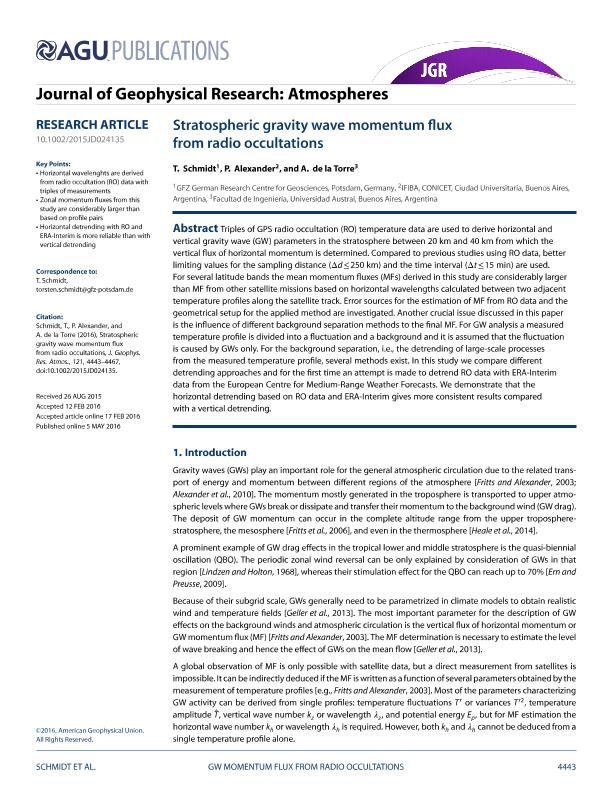Mostrar el registro sencillo del ítem
dc.contributor.author
Schmidt, T.
dc.contributor.author
Alexander, Pedro Manfredo

dc.contributor.author
de la Torre, Alejandro

dc.date.available
2018-05-02T18:29:25Z
dc.date.issued
2016-02
dc.identifier.citation
Schmidt, T.; Alexander, Pedro Manfredo; de la Torre, Alejandro; Stratospheric gravity wave momentum flux from radio occultations; American Geophysical Union; Journal of Geophysical Research; 121; 9; 2-2016; 4443-4467
dc.identifier.issn
0148-0227
dc.identifier.uri
http://hdl.handle.net/11336/43907
dc.description.abstract
Triples of GPS radio occultation (RO) temperature data are used to derive horizontal and vertical gravity wave (GW) parameters in the stratosphere between 20 km and 40 km from which the vertical flux of horizontal momentum is determined. Compared to previous studies using RO data, better limiting values for the sampling distance (Δd≤250 km) and the time interval (Δt≤15 min) are used. For several latitude bands the mean momentum fluxes (MFs) derived in this study are considerably larger than MF from other satellite missions based on horizontal wavelengths calculated between two adjacent temperature profiles along the satellite track. Error sources for the estimation of MF from RO data and the geometrical setup for the applied method are investigated. Another crucial issue discussed in this paper is the influence of different background separation methods to the final MF. For GW analysis a measured temperature profile is divided into a fluctuation and a background and it is assumed that the fluctuation is caused by GWs only. For the background separation, i.e., the detrending of large‐scale processes from the measured temperature profile, several methods exist. In this study we compare different detrending approaches and for the first time an attempt is made to detrend RO data with ERA‐Interim data from the European Centre for Medium‐Range Weather Forecasts. We demonstrate that the horizontal detrending based on RO data and ERA‐Interim gives more consistent results compared with a vertical detrending.
dc.format
application/pdf
dc.language.iso
eng
dc.publisher
American Geophysical Union

dc.rights
info:eu-repo/semantics/openAccess
dc.rights.uri
https://creativecommons.org/licenses/by-nc-sa/2.5/ar/
dc.subject
Radio Occultation
dc.subject.classification
Meteorología y Ciencias Atmosféricas

dc.subject.classification
Ciencias de la Tierra y relacionadas con el Medio Ambiente

dc.subject.classification
CIENCIAS NATURALES Y EXACTAS

dc.title
Stratospheric gravity wave momentum flux from radio occultations
dc.type
info:eu-repo/semantics/article
dc.type
info:ar-repo/semantics/artículo
dc.type
info:eu-repo/semantics/publishedVersion
dc.date.updated
2018-04-27T18:53:31Z
dc.journal.volume
121
dc.journal.number
9
dc.journal.pagination
4443-4467
dc.journal.pais
Estados Unidos

dc.journal.ciudad
Washington
dc.description.fil
Fil: Schmidt, T.. Geoforschungszentrum Potsdam; Alemania
dc.description.fil
Fil: Alexander, Pedro Manfredo. Consejo Nacional de Investigaciones Científicas y Técnicas. Oficina de Coordinación Administrativa Ciudad Universitaria. Instituto de Física de Buenos Aires. Universidad de Buenos Aires. Facultad de Ciencias Exactas y Naturales. Instituto de Física de Buenos Aires; Argentina
dc.description.fil
Fil: de la Torre, Alejandro. Universidad Austral. Facultad de Ingeniería; Argentina. Consejo Nacional de Investigaciones Científicas y Técnicas; Argentina
dc.journal.title
Journal of Geophysical Research

dc.relation.alternativeid
info:eu-repo/semantics/altIdentifier/doi/http://dx.doi.org/10.1002/2015JD024135
dc.relation.alternativeid
info:eu-repo/semantics/altIdentifier/url/https://agupubs.onlinelibrary.wiley.com/doi/abs/10.1002/2015JD024135
Archivos asociados
